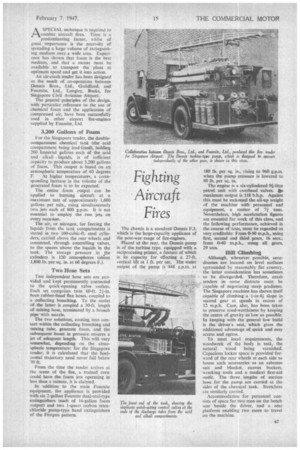Fighting Aircraft Fires
Page 41

If you've noticed an error in this article please click here to report it so we can fix it.
ASPECIAL technique is required to combat aircraft fires. Time is a predominating factor, whilst of great importance is the necessity of spreading a large volume of extinguishing medium over a wide area. Experience has shown that foam is the best medium, and that a means must be available to transport the plant at optimum speed and get it into action.
An air-crash tender has been designed as the result of co-operation between Dennis Bros., Ltd., Guildford. and Foamite, Ltd.. Langley, Bucks, for Singapore Civil Aviation Airport.
The general principles of the design. with particular reference to the use of chemical foam and the application of compressed air, have been successfullY used in other airport fire-engines supplied by Foamite, Ltd.
3,200 Gallons of Foam
For the Singapore tender, the doublecompartment chemical tank (the acid compartment being lead-lined), holding 200 Imperial gallons each of the acid and alkali liquids, is of sufficient capatity to produce about 3,200 gallons of foam. This output is based on an atmospheric temperature of 60 degrees
F. At higher temperatures, a corresponding increase in the volume of the generated foam is to be expected.
The entire foam output can be applied to burning aircraft at a maximum rate of approximately 1,600 gallons per min., using simultaneously two jets each of 800 g.p.m. It is not essential to employ the two jets on every occasion.
The air, or nitrogen. for forcing the liquids from the tank compartments is stored in two 100-cubic-ft. steel cylinders, carried above the rear wheels and connected, through controlling valves, to the spaces above the liquids in the tank. The storage pressure in the cylinders is 120 atmospheres (*.out 1,800 lb. per sq. in. at 60 degrees F.).
Two Hose Sets Two independent hose sets are provided and kept permanently connected to the quick-opening valve outlets. Each set comprises twin 60-ft. 2-Ha. bore rubber-lined flax hoses, coupled to a collecting breeching. To the outlet of the latter is coupled a 30-ft. length of mixing hose, terminated by a branch pipe with nozzle.
The two solutions, coming into contact within the collecting breeching and mixing tube, generate foam, and the subsequent boost in pressure ensures a jet of adequate length. This will vary somewhat, depending on the atmospheric temperature; for the Singapore tender, it is calculated that the horizontal trajectory need never fall below 70 ft_ From the time the tender arrives at the scene of the fire, a trained crew could have the foam jets operating in less than a minute, it is claimed.
In addition to the main Foamite equipment, the appliance is provided with six 2-gallon Foamite dual-seal-type extinguishers (each of 16-gallon foam output) and two 1-quart carbon tetrachloride pump-type hand extinguishers of the Firegun pattern. The chassis is a standard Dennis F.3, which is the large-capacity appliance of the post-war range of fire-engines.
Placed at the rear, the Dennis pump is of the turbine type, equipped with a reciprocating primer, a feature of which is its capacity for effecting a 27-ft. vertical lift at 1 ft. per sec. The water output of the pump is 448 g.p.m. at 180 lb. per sq. in, rising to 960 g.p.m. when the pump pressure is lowered to 80 lb. per sq. in.
The engine is a six-cylindered petrol unit with overhead valves. Os maximum output is 118 b.h.p. Against this must he reckoned the all-up weight of the machine with personnel and equipment, a matter of 7itons. Nevertheless, high acceleration figures are essential for work of this class, and the following performance, achieved in the course of tests, must be regarded as very creditable: From 0-30 m.p.h., using first, second and third gears, 16 secs.; from 0-40 m.p.h., using all gears. 29 secs.
Hill Climbing
Although, whenever possible, aerodromes are located on level surfaces surrounded by reasonably flat country, the latter consideration has sometimes to be disregarded. Therefore, crash tenders in some districts must be capable of negotiating steeji gradients. The Singapore machine has shown itself capable of climbing a slope in second gear at speeds in excess of 12 m.p.h. Care, also, has been taken to preserve road-worthiness by keeping the centre of gravity as low as possible. In keeping with the general low build is the driver's seat, which gives the additional advantage of quick and easy access and egress.
To meet local requirements, the woodwork of the body is teak, the natural wood being varnished. Capacious locker space is provided forward of the rear wheels at each side to house such accessories as an asbestos suit and blanket, canvas buckets. wrecking tools and a medical first-aid outfit. The three lengths of suction hose for the pump are carried at the sides of the chemical tank. Stretchers are similarly carried.
Accommodation for personnel consists of space for two men on the bench seat beside the driver, and a rear platform enabling two more to travel on the machine.




















































































